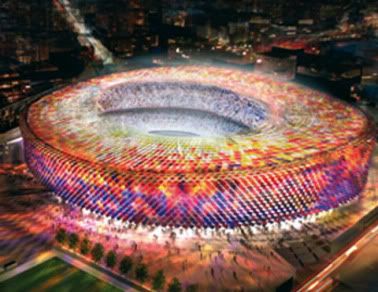CAMP NOU
Barcelona's history is full of glorious and unforgettable moments, divided into three periods. In early days the club often switched the playground, in the second stage the club stayed at Les Corts and in the third stage our beloved club settled on the ground of »the Camp Nou«.
After the war Les Corts couldn't sustain the multitude of fans, so the necessity of a new stadium provoked the construction of the biggest stadium in Europe. So, on September 19, 1950, FC Barcelonas Board of Directors, presided by Agustí Montal Galobart, purchased a plot of land next to the Maternitat, fairly close to the site of the old Les Corts ground.
Agustí Montal Galobart
A troublesome period followed, when the new stadiums commission 9, 1951) changed their minds about the site of the project, opting for an area at the top of the Diagonal. Negotiations with the Administrators bore little fruit and never reached a definitive agreement. The issue was left on hold until Francesc Miró-Sans was elected president of FC Barcelona (November 14, 1953). The new president was particularly insistent that the project for a new stadium should go ahead immediately and one of the first things he did after coming to power (February 18, 1954) was to situate the new site on the land purchased in 1950 and not at the top of the Diagonal. So it was that, on March 28, in front of 60,000 fans, he laid the first stone of the Camp Nou, watched by the president of the Civil Government, Felipe Acedo Colunga, and blessed by the Archbishop of Barcelona, Gregorio Modrego.
The construction
The architects of the new stadium were Francesc Mitjans Miró and Josep Soteras Mauri, under collaboration with Lorenzo García Barbón. One year later the club handed the construction to the INGAR SA Company, which put forward an estimate for 66,620,000 pesetas for completion of the building in 18 months. However, the eventual cost was considerably higher than the original proposal, reaching 288 million pesetas, a figure that had to met by successive emissions of obligatory mortgages (100 million pesetas) and bank loans (60 million pesetas). This was enough to finance the construction of the stadium, but the Club would be repaying that debt for several years afterwards.
The Inauguration
Stadium was inaugurated on September 24, 1957. A special commission was organised whose task was to organise the kind of opening ceremony that the occasion warranted, with two people in charge of the operation: Aleix Buxeres (public relations) and Nicolau Casaus (organisation). Those days will go down in club history, and were set to words by the great poet Josep M. de Sagarra in his sonnet titled 'Azul Grana', while an anthem was written in honour of the new FC Barcelona stadium, with Josep Badia putting the words to Adolf Cabané’s music.

The terraces of the Camp Nou, still not quite complete, were opened to more than 90,000 people, as representatives of all of the football clubs of Catalonia paraded across the field, along with members of the sections of the Club, Barcelona fan clubs and different teams belonging to the Club. The aforementioned hymn was then sung, followed, at four thirty in the afternoon, by the inaugural match. FC Barcelona played a Polish team from Warsaw. The Barcelona line-up in the new stadium was formed by: Ramallets, Olivella, Brugué, Segarra, Vergés, Gensana, Basora, Villaverde, Martínez, Kubala and Tejada. In the second half the Barcelona eleven was the following: Ramallets, Segarra, Brugué, Gràcia, Flotats, Bosch, Hermes, Ribelles, Tejada, Sampedro and Evaristo. The game ended with Barcelona winning 4-2 with goals from Eulogio Martínez (who, in the 11th minute scored the first ever goal at the Camp Nou), Tejada, Sampedro and Evaristo. During the break, 1,500 members of the Agrupació Cultural Folklòrica de Barcelona danced an enormous sardana and 10,000 doves were set free. And so began a new era in the history of FC Barcelona.

Inovations and renovations
Since the day it was opened, the Camp Nou has been improving day by day and it has adapted itself to the passing of time. Over the years the Club has renewed different areas of the installations and the surroundings, new areas have been built and the stadium has been equipped with the latest technology. These are the renovations which the Camp Nou has gone through.
Pope's Visit
On November 17, 1982, FC Barcelona was honoured by the visit of Pope John Paul II, who performed a solemn mass at the Camp Nou before 120.000 believers, who stoically tolerated the heavy rain that fell that day. President Josep Lluís Núñez presented His Holiness with membership card number 108,000.
The new Camp Nou

































